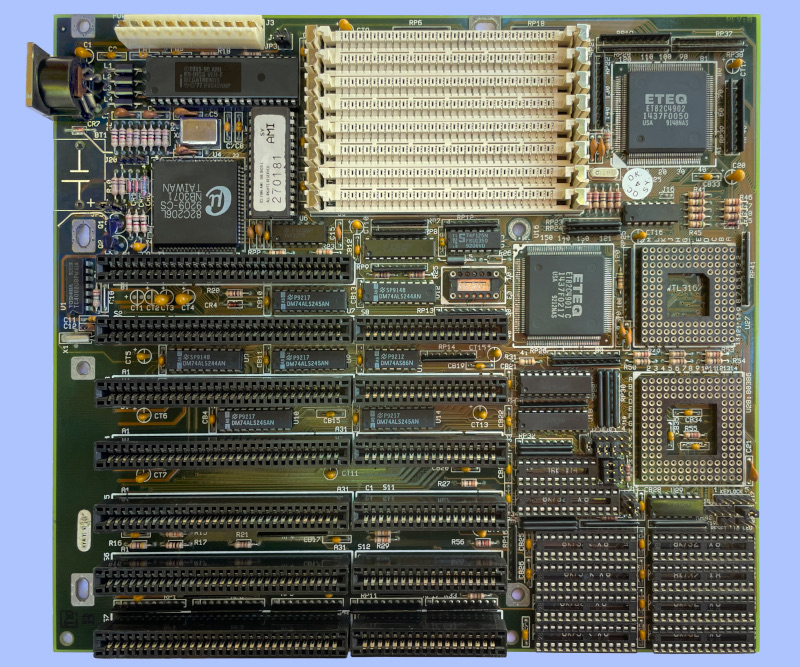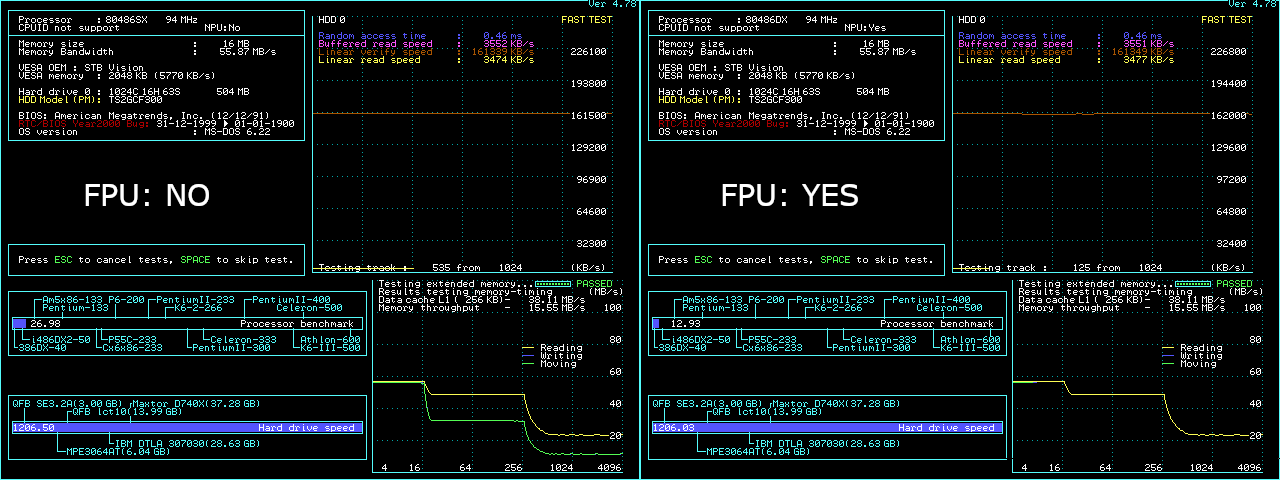While waiting on BitWrangler's next steps with his IBM Bl3 system i am going to post information for one more 386 motherboard.
Soyo 386DX/33(?) revision B, based on ETEQ "Bengal" ET82C4901, ET82C4902 chipset.

Most boards based on ETEQ chipsets tend to be wide PCBs with low level of integration - dont inspire confidence.
2-3 models have the right bones, including this one here, so level of interest was significant.
The motherboard came in really bad condition.
Covered entirely under tick layer of dust and dirt.
Massive battery leak in the upper left corner that marinated all components in the area over many years.
Damaged traces on both sides.
Up to half a millimeter tick crust on all metal surfaces.
Solder pads brittle and with compromised conductive properties.
Keyboard connector was a corroded mess.
Chances for positive outcome were minimal.
Obviously no signs of life upon initial power-on.
Threw everything i got at it.
Multiple passes of acetone and vinegar scrubbing.
Hot water showers and brushing.
Careful removal of the hard crusty bits with multiple precise tools.
Tracing and fixing broken lines.
Replacing the keyboard connector.
Replacing keyboard controller and BIOS sockets.
Still no life.
At some point realized that some of the pins and pads of the 206 chip were not electrically connected despite visual inspection suggesting otherwise.
Apparently they corroded badly enough.
Scraped the upper layer of corrosion and tried to solder them, but for my surprise no amount of flux would make the solder stick.
Ended up simply covering the pairs of pins/pads with blobs of solder. Does not look good, but did the job.
That last fix did it and the motherboard came to life. For my great pleasure.
Several layers of conformal coating hid the damage and greatly improved optics.
Btw, the build quality of this assembly is great.
The design of the RAM sockets is very interesting. They don't require pulling handles sideways to free the memory modules.
Everything needed is to simply push or pull the modules. The mechanism works in such a way that once inserted they are stuck there for good, but applying the right amount of force in the opposite direction frees them just fine.
Very handy.
For some reason had to keep PARITY CHECK turned-off.
Tried different types of memory modules but nothing worked.
At the same time all memory tests are happy, so not sure what's up with that.
Components used for testing:
256Kb L2 cache.
16Mb RAM, 50ns rated chips.
Cirrus Logic GD-5434 video card with 2Mb RAM.
Standard IDE controller with CF card.
Level 2 cache can operate in write-back mode if the corresponding socket is populated with 16k x 4 SRAM chip.
Performance improves further in this configuration.
--- AMD 386DX running at 45MHz, ISA bus at 15MHz
50MHz is possible, but system is quite unstable.
Tested at 45MHz.
Everything just worked. Nothing more to say really.
All BIOS settings on max, except:
AT BUS CLOCK SELECT = CLOCK/3 (best is /2)
DRAM WRITE CYCLE = 1 W/S (best is 0)
DRAM READ CYCLE = 3 W/S (best is 0)
SRAM WRITE CYCLE = 1 W/S (best is 0)

Intermediate level performance in DOS and Windows graphics tests.
Didn't bother with offline graphics tests given the above - it was obvious that it won't bring a surprise.
--- TI 486SXL2
For my big surprise the SXL2 processors didn't work at all on this motherboard.
POST does not always complete, random hangs and so on.
Tried hard to overcome the issues but without success.
First time seeing SXL2 not on the same page with 386DX.
Until now i thought they are 100% compatible.
--- IBM BL3 running at 90MHz (2x45), ISA bus at 15MHz
This motherboard simply loves the BL3 processor.
Stuff just works. No effort at all. Nothing more to say really.
All BIOS settings on max, except:
AT BUS CLOCK SELECT = CLOCK/3 (best is /2)
DRAM WRITE CYCLE = 1 W/S (best is 0)
DRAM READ CYCLE = 2 W/S (best is 0)
SRAM WRITE CYCLE = 1 W/S (best is 0)
PAGE MODE = DISABLED (best is ENABLED)

Performance is impressive !
Number 2 in Quake 1.
Number 4 in Doom.
Number 3 in the heavy offline graphics tests and PC Player Benchmark.
And that is a 45/90MHz system.
Will be looking for more of this ETEQ stuff in the future for sure.
---
The combined benchmark results have been updated accordingly.
Look for Soyo 386DX.
---
This is my first experience with ETEQ silicon and i like it. Lots of potential.
With that said, there are other motherboards based on ETEQ chipsets:
- 386 designs with low level of integration that just don't inspire confidence.
- Hybrid 386/486 builds with VLB slots. Some of them don't have FPU sockets. Hope to be able to try some of them one day.
- Pure 486 ISA/VLB systems that don't look very promising. Probably a pass.
Feedback will be welcome.

